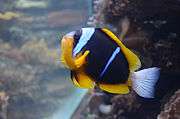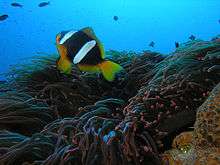Allard's clownfish
| Allard's Clownfish | |
|---|---|
| | |
| Amphiprion allardi in Aquarium Finisterrae | |
| Scientific classification | |
| Kingdom: | Animalia |
| Phylum: | Chordata |
| Class: | Actinopterygii |
| Order: | Perciformes |
| Family: | Pomacentridae |
| Subfamily: | Amphiprioninae |
| Genus: | Amphiprion |
| Species: | A. allardi |
| Binomial name | |
| Amphiprion allardi Klausewitz, 1970[1] | |
Amphiprion allardi, (Allard's anemonefish) is a marine fish belonging to the family Pomacentridae, the clownfishes and damselfishes and was named after Jack Allard by Herbert Axelrod after his visit to Allards Collecting Station in Kenya.
Characteristics of Anemonefish
Clownfish or anemonefish are fishes that, in the wild, form symbiotic mutualisms with sea anemones and are unaffected by the stinging tentacles of the host anemone, see Amphiprioninae § Symbiosis and mutualism. The sea anemone protects the clownfish from predators, as well as providing food through the scraps left from the anemone's meals and occasional dead anemone tentacles. In return, the clownfish defends the anemone from its predators, and parasites.[2] Clownfish are small-sized, 10–18 centimetres (3.9–7.1 in), and depending on species, they are overall yellow, orange, or a reddish or blackish color, and many show white bars or patches. Within species there may be color variations, most commonly according to distribution, but also based on sex, age and host anemone. Clownfish are found in warmer waters of the Indian and Pacific oceans and the Red Sea in sheltered reefs or in shallow lagoons.
In a group of clownfish, there is a strict dominance hierarchy. The largest and most aggressive fish is female and is found at the top. Only two clownfish, a male and a female, in a group reproduce through external fertilization. Clownfish are sequential hermaphrodites, meaning that they develop into males first, and when they mature, they become females.
Description
Adults are an dark-brown to black with two white bars with black edging encircling the body. The caudal fin is white with other fins orange.[3] They have 10-11 dorsal spines, 2 anal spines, 15-17 dorsal soft rays and 15-17 anal soft rays.[4] They reach a maximum length of 14 cm (5 1⁄2 in).[3]
Color variations
None known.
Similar species
Allard's anemonefish is almost identical to A. chrysopterus (Orange-fin anemonefish) and are distinguished by their geographic location. Allard's anemonefish is similar to the nearby A. latifasciatus (Madagascar anemonefish) however A. latifasciatus has a forked caudal fin which is yellow.[3]
-

A. allardi (Allard's anemonefish)
-

A. chrysopterus (Orange-fin anemonefish), Palau
-

A. latifasciatus (Madagascar anemonefish) showing the distinctive forked tail
Distribution and habitat
Allard's anemonefish is found in east Africa between Kenya and Durban.[3] They are usually found near to or within the tentacles of their host anemones.
Host anemones
Allard's anemonefish is associated with the following species of anemones: [3]
- Entacmaea quadricolor Bubble-tip anemone
- Heteractis aurora beaded sea anemone
- Stichodactyla mertensii Mertens' carpet sea anemone
References
- ↑ Bailly, N. (2010). Nicolas Bailly, eds. "Amphiprion allardi Klausewitz, 1970". FishBase. World Register of Marine Species. Retrieved 2011-12-24.
- ↑ "Clown Anemonefish". Nat Geo Wild : Animals. National Geographic Society. Retrieved 2011-12-19.
- 1 2 3 4 5 Fautin, Daphne G.; Allen, Gerald R. (1997). Field Guide to Anemone Fishes and Their Host Sea Anemones. Western Australian Museum. ISBN 9780730983651. Archived from the original on 10 January 2015.
- ↑ Froese, Rainer and Pauly, Daniel, eds. (2014). "Amphiprion allardi" in FishBase. November 2014 version.
External links
| Wikimedia Commons has media related to Amphiprion allardi. |
| Wikispecies has information related to: Amphiprion allardi |
- "Amphiprion allardi". Integrated Taxonomic Information System. Retrieved 30 January 2006.
- Amphiprion allardi. Klausewitz, 1970. Retrieved through: World Register of Marine Species.